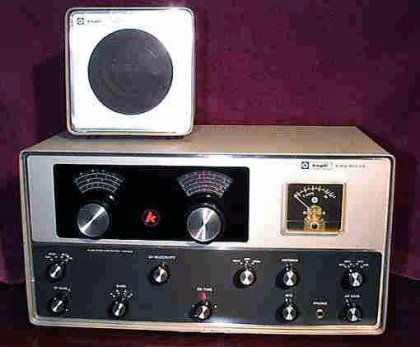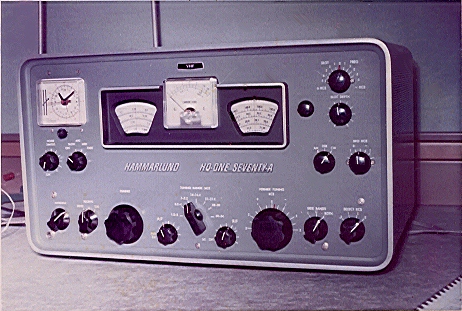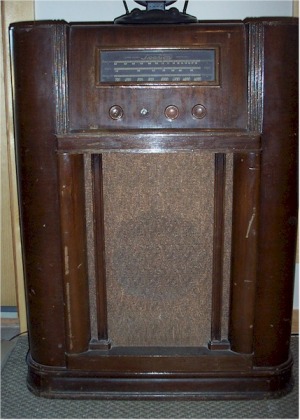 Ham Radio Nostalgia
Ham Radio Nostalgia
 Ham Radio Nostalgia
Ham Radio Nostalgia
Baltimore Junior College campus
After high school I went on to Baltimore Junior College (BJC) to study electronics in the fall of 67. In college, I made new friends who shared my interest in amateur radio. We quickly discovered that the college had a radio club. The radio club did not have any active members so my friends and I recruited new members from our electronics classes. The BJC club station which consisted of a Heathkit DX-20 crystal controlled transmitter, a Hammarlund HQ-170A receiver, a Heathkit HX-30 six-meter transmitter, dipole antennas for 40 and 80 meters, and a 6 meter halo on the roof of the building. The club had 6 members in 1969. Three of the members had an amateur radio license. In the photo below-right, I am in the back row, second from the left.
Baltimore Junior College ham radio club station
Baltimore Junior College ham radio club members
In the fall of 1967, with the help of the club advisor, I found out how to learn morse code correctly... by sound. One of our lab instructors was an ex-ham who gave me lots of advice. I started studying the code again for the third and final time. To aid my studies, I purchased an Allied Radio code practice LP record (you remember those big round black vinyl things). By the end of 1967 I was copying 5 words per minute from the record, which I had committed to memory and started listening to on-the-air QSOs from the college club station. A month or two went by before I was absolutley certain that I could pass the novice test "under pressure." My buddy, Chris WN3KEV, had received his novice license a few months earlier. His girlfriend's father was a ham and had given him his test. In early 1968 we made the arrangements to take the exam one evening after class at the home of his girlfriend.
In those days the process of obtaining a novice license took a long time: (1) you had to find a licensed amateur general class or higher to administer the test; (2) request the test materials from the FCC via snail mail; (3) wait for the materials to arrive via snail mail; (4) take the test and hopefully pass; (5) send the test materials back to the FCC by snail mail; and (6) wait for your license to come via snail mail. You did not want to fail the test because you had to go through this lengthy process a second time if you did. In early April 1968 I took my novice test and passed with flying colors. Unfortunately, since I met my novice examiner only once, I don't remember his name or callsign. By the time I took the test I was copying about 10 words per minute and had started assembling my station.

Knight kit R100A
In early 1968, while I was waiting to take my novice test, I purchased my first radio kit, an Allied Radio short wave receiver, the R-100A as shown in the photo on the left. The R-100A was a general coverage receiver with bandspread tuning that covered the ham bands. I spent several weeks carefully building the receiver in the evenings. I attended college during the day and worked part time in the evening and on weekends at Read's drug store to earn money to pay for school and purchase my radio equipment. Once I had the receiver built and working I copied on-the-air QSOs at home building my speed above 5 words per minute. I also found time to study for my college courses. Fortunately, electronics theory was an easy study because I was using and applying it daily in my pursuit of an amateur radio license.
After using the R-100A receiver at home "un-aligned" for several weeks, I took it to the college electronics lab and aligned the receiver IF stages and calibrated the main and bandspread tuning dials. I then took it into the club station radio room and hooked it to the dipole antenna. The receiver seemed really "hot" and I was pleased with the result, then after a few minutes of listening, the receiver went silent. I spent many hours of troubleshooting trying to isolate the problem. I asked my lab instructors to go over the receiver with the lab's test equipment and none of us could find the problem. After several weeks of swapping tubes, checking and double checking everything, I wrote a letter to Allied describing my problem and all that had been done to troubleshoot the receiver. A few weeks later I received a response from Allied. To my surprise, they told me to return the receiver for a full refund. So with my $125 back in my pocket I decided to save up more money and purchase a commercially built receiver.

Hammarlund HQ-170A VHF
While I was waiting for my check to come from Allied, I ventured into Baltimore City in search of a new receiver. My dream receiver at that time was the Hammarlund HQ-170A (shown at left) which I used at the college club station, but my meager income could not afford the top of the line amateur receiver. Instead, I settled on the little brother of the HQ-170A, the HQ-110A which was a ham band only receiver. After traveling around Baltimore City to the various amateur radio dealers, I found my best deal at the Electronic Trading Post located in Highlandtown on Broadway Street in east Baltimore a few miles from where I lived. When I placed the order for the receiver, the store proprietor tried to talk me into purchasing a second hand Drake 2B receiver instead. I had never heard of Drake and had my mind set on the Hammurland since that was what I was familar with. As it turned out, I should have taken his advice and saved a few dollars because I eventually purchased a Drake 2B about 4 years later.
After ordering the Hammarlund HQ-110A, I continued my search for a transmitter and found a used Eico 720 at Bainesville Electronics. At that time Bainesville had a section of the store devoted to used ham equipment. So with a transmitter in hand and a new receiver on order, I continued to prepare for the day my license would arrive. I copied on-the-air QSOs from the college club station and on an old shortwave receiver that I had at home. I practiced tuning the Eico 720 (load and dip, load and dip) into a dummy load, a 100 watt light bulb. I regularly visited the amateur radio stores in the Baltimore area looking for "stuff" to complete my station. In those days Baltimore had a large selection of amateur radio stores... the Amateur Radio Center, Electronic Trading Post, Kann-Ellert, Bainesville Electronics, Heathkit (just down the street from Bainesville), and a small shop on Eastern Avenue, I think the name was Modern Electronics.
Below is a photo taken in the Baltimore Junior College electronics lab where I studied electronics from 1967 to 1969. Shown in the picture are my friends who helped me get my start in amateur radio. The fellow standing next to me is Chris - WN3KEV. The other fellow, Ralph didn't have his license yet. I don't think he ever did get his amateur radio license.
Baltimore Junior College electronics lab
Baltimore Junior College lab

Sparton console radio
Sparton radio
After an agonizing 11 weeks of waiting, my license arrived in the mail on June 19, 1968. I was issued the callsign WN3KOC. Novice licenses at that time were good for one year. To stay on the air, you had to upgrade to technician or general or a higher class license before your novice ticket expired.
My Hammarlund HQ-110A was still on order so my first dozen or so contacts were made with a make-shift setup. To get on the air immediately, I pressed into service a 1940's shortwave receiver that my neighbor had given me. It consisted of a bare chassis (the radio minus the cabinet). It was made by Sparton and covered the AM broadcast band and several shortwave bands (see photo above). This receiver did not have any bandspread or a BFO, so I had to improvise. Using the tune function on the Eico 720 to simulate a BFO, I was able to find the 40 meter novice band on the dial and copy strong CW signals. I had no means of switching the antenna from the transmitter to the receiver, so I moved the antenna coax between the transmitter and receiver manually during QSOs. So... in addition to building my CW skills I got some exercise while operating! I became really fast at switching the connections otherwise I would miss some of the copy.Earlier in 1968 while building my station, I had strung up a 40 meter dipole that just fit into the space from the front of our row house down to a clothesline pole at the end of our back yard. The highest part of the antenna was about 25 feet off the ground. At first I worked 40 meters because the Sparton receiver did not cover the 15 meter band. The HQ-110A arrived about a week later. I started working 15 meters and listened to 10 meters but rarely heard any signals. I continued manually switching the antenna between the transmitter and receiver until I met a ham on-the-air one day who lived two blocks away, George - WA3EIW. George gave me a relay and showed me how to use it to switch the antenna between the transmitter and receiver using 110 volts ac from the auxillary socket on the back of the Eico 720 transmitter. George also gave me a schematic for a antenna tuner to match my dipole on the other bands. I completed the construction of the tuner in early 1969. During spring break, my college buddies and I took a weekend trip to New York City. In New York City's electronics stores I found a metal cabinet and the last few parts I needed to complete the tuner.
Shown below are the first entries in my novice logbook. In 1968 FCC regulations required you to log every transmission regardless of whether it was an unanswered CQ or just a test transmission. My first QSO was with Chris, WN3KEV, my friend from college. My first "out-of-town" QSO was with Joe, WN8BDN in Morgantown, West Virginia. I made 5 contacts on my first day as a ham. My first few logbooks were filled with unanswered CQs.
First log book
First log book entries
Novice license